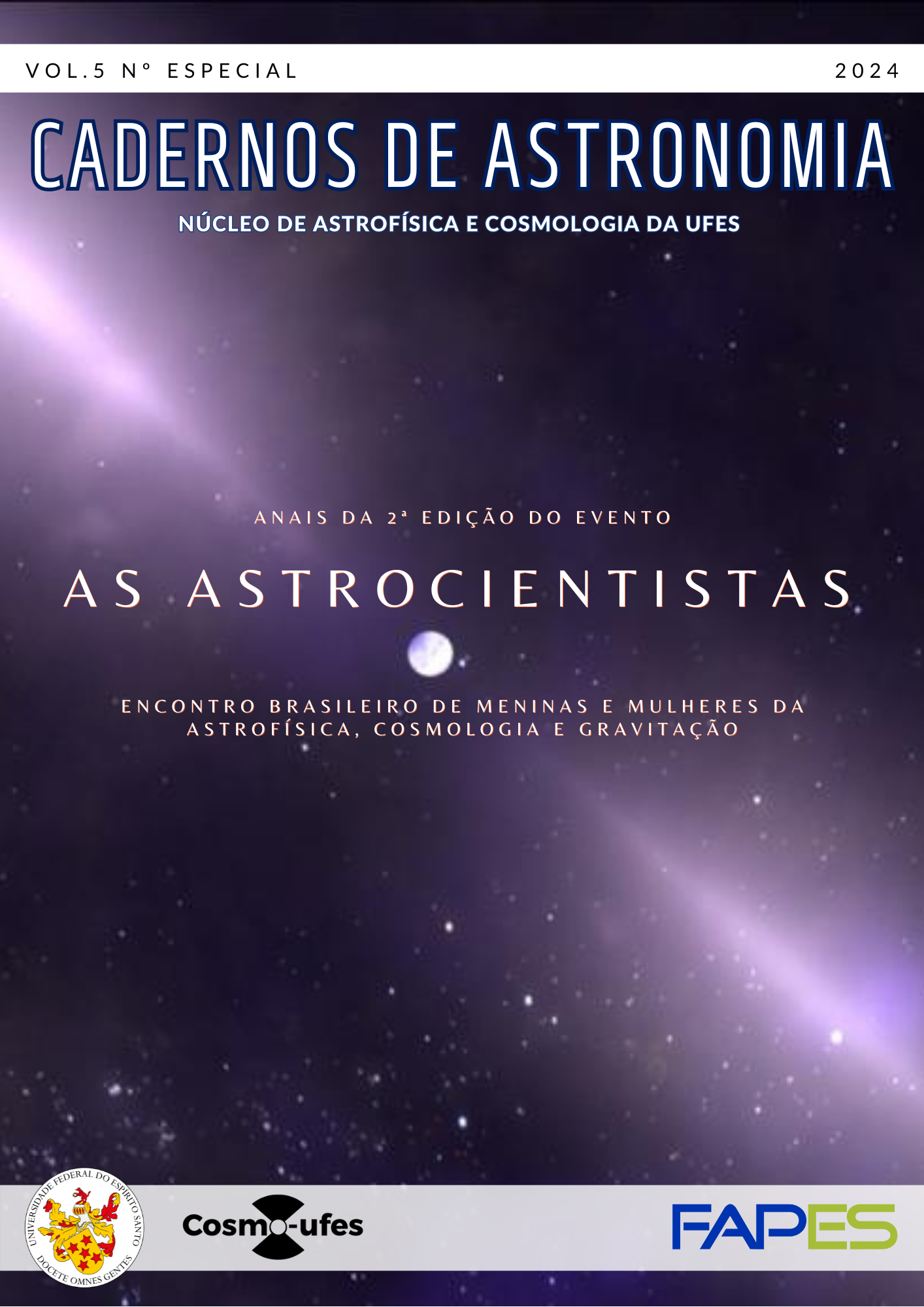Study of ionized diffuse gas in edge-on galaxies
DOI:
https://doi.org/10.47456/Cad.Astro.v5nEspecial.44959Keywords:
Astrophysics, photoionization, diffuse ionized gasAbstract
One of the main components of a galaxy is gas, which can be found in different densities and ionized by different sources. The extraplanar diffuse ionized gas (DIG), the one with the lowest density located outside the plane, does not yet have its main sources of ionization well understood, which is the objective of this study. Using full-field spectroscopy data from eight edge-on galaxies obtained with the Multi-Unit Spectroscopic Explorer instrument on the Very Large Telescope (MUSE/VLT), we analyze the behavior of emission line ratios in function of the distance z to the galactic plane. Our objective is to investigate two main sources of ionization in the extraplanar DIG: escaping radiation from regions with star formation, and hot low-mass evolved stars (HOLMES). Among our sample, we carried out a preliminary analysis of the extraplanar DIG of the galaxy ESO157-49. The Hα equivalent width values of this object fall with distance from the plane, indicating that photon escape plays a smaller role in this region. Furthermore, line ratios such as [N II]/Hα and [S II]/Hα increase to great heights, and if combined with high values of [O III ]/Hβ , suggests the existence of harder ionizing sources such as HOLMES. To quantify the contribution of each of the proposed ionizing sources, we will compare our observational measurements of emission lines with theoretical models of photoionization.
Downloads
References
E. P. Hubble, Extragalactic nebulae., The Astrophysical Journal 64, 321 (1926). DOI: https://doi.org/10.1086/143018
G. de Vaucouleurs et al., Third Reference Catalogue of Bright Galaxies (1991). DOI: https://doi.org/10.1007/978-1-4757-4363-0
Spiral Galaxy (Side View, Purple), https://universe.nasa.gov/resources/198/spiral-galaxy-side-view-purple/, accessed: 2023-11-19.
Spiral Galaxy (Purple), https://universe.nasa.gov/resources/200/spiral-galaxy-purple/, accessed: 2023-11-19.
L. M. Haffner et al., The warm ionized medium in spiral galaxies, Reviews of Modern Physics 81(3), 969 (2009). ArXiv:0901.0941. DOI: https://doi.org/10.1103/RevModPhys.81.969
A. Zurita, M. Rozas e J. E. Beckman, The origin of the ionization of the diffuse interstellar medium in spiral galaxies. I. Photometric measurements, Astronomy & Astrophysics 363, 9 (2000).
F. Hoyle e G. R. A. Ellis, On the Existence of an Ionized Layer about the Galactic Plane, Australian Journal of Physics 16, 1 (1963). DOI: https://doi.org/10.1071/PH630001
Nublado, paisagem no céu, https://br.freepik.com/fotos-gratis/nublado-no-papel-de-parede-da-paisagem-do-ceu_19380998.htm, accessed: 2023-11-19.
NGC1566 Hubble Tangos with a Dancer in Dorado, https://science.nasa.gov/missions/hubble/hubble-tangos-with-a-dancer-in-dorado/, accessed: 2023-11-19.
N. Flores-Fajardo et al., Ionization of the diffuse gas in galaxies: hot low-mass evolved stars at work, Monthly Notices of the Royal Astronomical Society 415(3), 2182 (2011). ArXiv: 1104.0525. DOI: https://doi.org/10.1111/j.1365-2966.2011.18848.x
G. Stasińska, M. Trevisan e N. Vale Asari, Planetary Nebulae and the Ionization of the Interstellar Medium in Galaxies, Frontiers in Astronomy and Space Sciences 9, 913485 (2022). DOI: https://doi.org/10.3389/fspas.2022.913485
R. Bacon et al., The MUSE second-generation VLT instrument, in Ground-based and Airborne Instrumentation for Astronomy III, editado por I. S. McLean, S. K. Ramsay e H. Takami (2010), vol. 7735 de Society of Photo-Optical Instrumentation Engineers (SPIE) Conference Series, 773508. ArXiv:2211.16795.
S. Comerón et al., The kinematics of local thick discs do not support an accretion origin, Astronomy & Astrophysics 623, A89 (2019). ArXiv: 1901.10294. DOI: https://doi.org/10.1051/0004-6361/201833653
MUSE data-cube schematic representation, https://www.eso.org/public/blog/the-many-faces-of-galaxies/, accessed: 2023-11-19.
R. Cid Fernandes et al., Semi-empirical analysis of Sloan Digital Sky Survey galaxies - I. Spectral synthesis method, Monthly Notices of the Royal Astronomical Society 358(2), 363 (2005). ArXiv:astro-ph/0412481. DOI: https://doi.org/10.1111/j.1365-2966.2005.08752.x
T. Z. Flórido, Análise de linhas de emissão em galáxias: O gás difuso ionizado nas galáxias do MaNGA, Dissertação de Mestrado, UFSC (2018).
G. J. Ferland et al., CLOUDY 90: Numerical Simulation of Plasmas and Their Spectra, Publications of the Astronomical Society of the Pacific 110(749), 761 (1998). DOI: https://doi.org/10.1086/316190
C. Morisset, The Mexican Million Models database: a virtual observatory for gaseous nebulae, Mem. Societa Astronomica Italiana 80, 397 (2009). ArXiv:0909.3313.
E. A. D. Lacerda et al., Diffuse ionized gas in galaxies across the Hubble sequence at the CALIFA resolution, Monthly Notices of the Royal Astronomical Society 474(3), 3727 (2018). ArXiv:1711.07844. DOI: https://doi.org/10.1093/mnras/stx3022
Downloads
Published
How to Cite
Issue
Section
License
Copyright (c) 2024 Janayna de Souza Mendes, Natalia Vale Asari

This work is licensed under a Creative Commons Attribution 4.0 International License.






